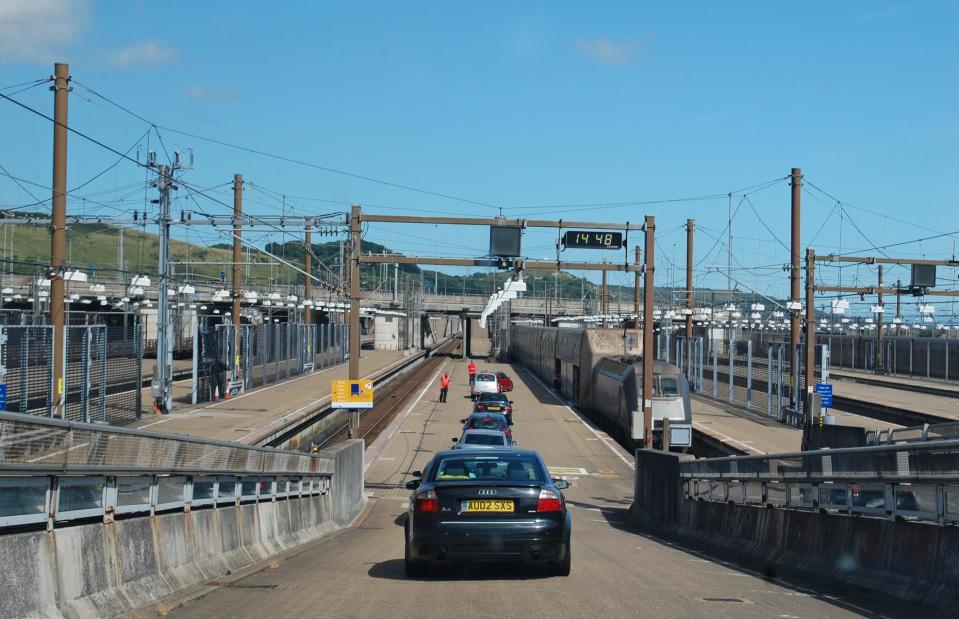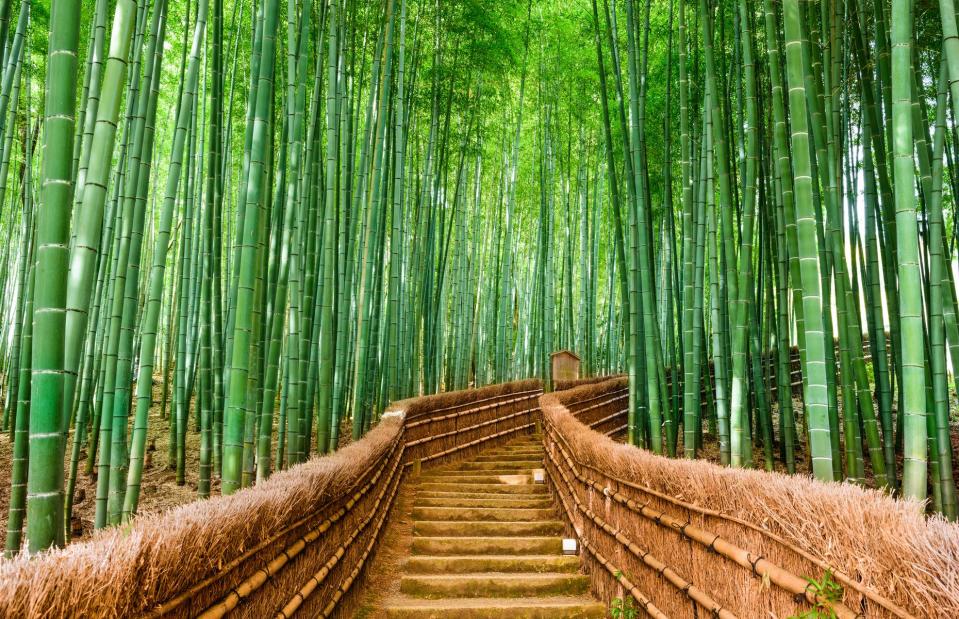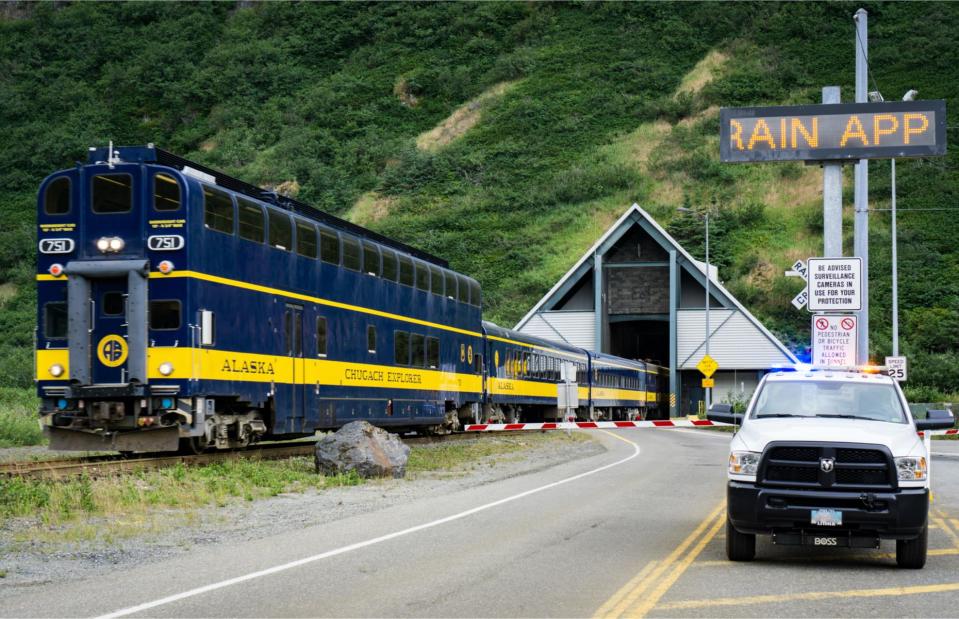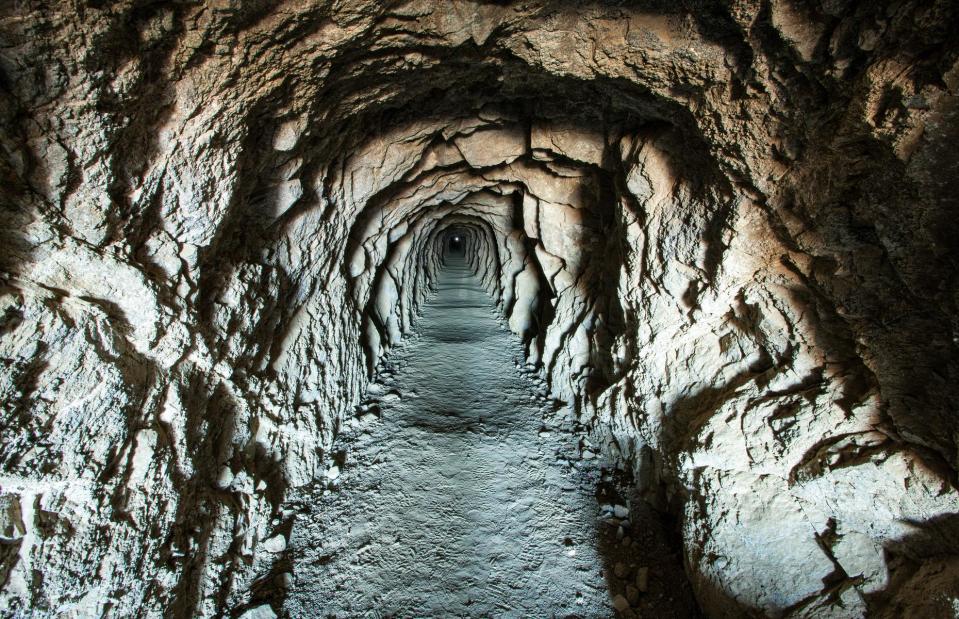The most beautiful tunnels in the world, which UK ones make the list?
Tunnel vision

Deatonphotos/Shutterstock
Since the dawn of time humankind has had the urge to tunnel and burrow, whether for safety, storage, irrigation or to extract natural resources. Recently our most extraordinary tunnels were dug for transportation. From modern engineering marvels and regenerated historic passages to naturally occurring tunnels, we dig deep to find some of the world’s most beautiful tunnels.
The Dark Hedges, Northern Ireland, UK

VanderWolf Images/Shutterstock
This haunting tunnel of beech trees in County Antrim known as the Dark Hedges shot to worldwide fame when it was used as the location for the Kingsroad in HBO’s Game of Thrones. The deciduous trees were originally planted in the 18th century by the Stuart family to create an awe-inspiring entrance to their grand mansion, Gracehill House. Today the ethereal feature encloses a section of the Bregagh Road, near Armoy. It's a public road although traffic bans have been imposed due to overcrowding.
The Lærdal Tunnel, Norway

Leonid Andronov/Shutterstock
West Norway’s Lærdal tunnel stretches over 15 miles (24.5km) between the Aurland and Lærdal municipalities, providing a ferry-free connection between Oslo and Bergen. It holds the title of the world's longest road tunnel. The impressive piece of infrastructure opened in 2000 after five years of construction and features three rock chambers, which are illuminated with colourful lights. It also has several state-of-the-art safety stations with emergency equipment and call boxes.
Tokyo Bay Aqua Line, Japan

KAI AYASE/Shutterstock
Built to connect the cities of Kawasaki and Kisarazu, Japan’s mighty part-bridge-part-tunnel structure the Aqua Line crosses Tokyo Bay. The tunnel part of the highway stretches for nearly six miles (9.6km) and is one of the longest undersea tunnels in the world. The bridge meets the tunnel on an artificial island called Umihotaru, meaning sea firefly. The ship-like structure is a rest stop and has viewing platforms where drivers can take in amazing views of Tokyo and beyond.
Stockholm metro, Sweden

JONATHAN NACKSTRAND/AFP/Getty Images
Stockholm’s subway system has been lauded as the longest art gallery in the world due to the paintings, installations, mosaics and sculptures that adorn the 100 stations that populate its 66-mile-long (106km) tunnel system. Artists have been working their magic on the platform walls, waiting halls and tunnels since 1957. Pictured here is Tekniska Högskolan station.
Gotthard Base Tunnel, Switzerland

Hannes Ortlieb/Wikimedia/CC BY-SA 3.0
The longest and deepest railway tunnel in the world, Switzerland’s Gotthard Base Tunnel stretches 35.5 miles (57km) and whisks passengers deep under the Swiss Alps. Constructed to provide a high-speed rail link between northern and southern Europe, at its deepest point it plummets to 1.5 miles (2.4km) underneath the mountains. The tunnel took 17 years to build, using giant tunnel-boring machines, and cost £9.3 billion ($12bn).
Seikan Tunnel, Japan

osap/Shutterstock
Before the Swiss completed the Gotthard Base Tunnel, the Japanese laid claim to having the longest train tunnel in the world. Now the Seikan Tunnel, which runs under the Tsugaru Strait and links Japan's Honshu Island with the northern neighbouring island of Hokkaido, holds the title of the world’s longest undersea tunnel. Completed in 1988, it was built for high-speed bullet trains, and is 33.4 miles (53.8 km) long in total, with 14.5 miles (23.3km) of it underwater.
Eisenhower Tunnel, Colorado, USA

FreezeFrames/Shutterstock
Located at an altitude of more than 11,000 feet (3,400m), the Eisenhower Tunnel (officially the Eisenhower–Edwin C. Johnson Memorial Tunnel) was a true engineering marvel when it opened as part of the Interstate 70 in 1979. It is the country’s longest mountain tunnel, the highest point in its interstate network and the world’s highest vehicular tunnel. The ground-breaking dual-bore tunnel, which goes through the Continental Divide, was carved into the mountains to ease travel between Colorado's eastern and western slopes.
Channel Tunnel, UK and France

Deatonphotos/Shutterstock
More than 30 miles (50.5km) long, the Channel Tunnel is the third longest train tunnel in the world. The railway connects Folkestone in England with Coquelles in France and runs beneath the English Channel – it’s 246 feet (75m) below the seabed at its deepest point and takes around 35 minutes to travel along. It was constructed between 1988 and 1994 and is formed of three tunnels – two for trains and a third service tunnel. It is recognised as one of the seven modern Wonders of the World by the American Society of Civil Engineers.
Mont Blanc Tunnel, France and Italy

FocusLuca/Shutterstock
Another feat of modern engineering when it opened in 1965, the Mont Blanc Tunnel was the world's longest road tunnel at 7.2 miles (11.6km). Today it remains a vital link for truck drivers and skiers, among others, linking Chamonix in France with Courmayeur in Italy’s Aosta Valley as it takes them under Europe’s tallest mountain, Mont Blanc. The tunnel passes almost exactly under the summit, where it's more than 8,000 feet (2,500m) beneath the surface.
Halnaker Tree Tunnel, England, UK

Mitotico/Shutterstock
This enchanting tunnel of trees is found along an ancient track in the South Downs National Park, which follows the old Roman road from London to Chichester. Also known as Mill Lane, it's now a key attraction on a delightful walk in West Sussex that goes through the foliage canopy and uphill onto the 18th-century Halnaker windmill on Halnaker Hill.
Glow Worm Tunnel, New South Wales, Australia

Ian Crocker/Shutterstock
A dark and dank disused railway tunnel surrounded by lush rainforest in New South Wales’ Wollemi National Park has become an unlikely tourist attraction. The 1,312-foot-long (400m) tunnel, which was built in the early 1900s to service the mines, has been overtaken by thousands of glow worms. Walkers can follow the uneven track through the pitch-black tunnel to see the colony, but torches need to be switched off to see its walls light up with the pinpricks of blue-green light – the spectacular bioluminescence that the insect larvae give off.
Tunnel Log, California, USA

Benny Marty/Shutterstock
When a giant sequoia fell across a road in the Sequoia National Park in 1937, rather than move it, the park decided to cut a tunnel through it. Now driving through the tree has become one of the Californian park’s must dos. The tunnel, which is 17 feet wide and 8 feet high (5.2m by 2.4m), can be found along the Crescent Meadow Road in the Giant Forest. It’s thought the towering tree was more than 2,000 years old when it fell down due to natural causes.
Arashiyama Bamboo Grove, Japan

Sean Pavone/Shutterstock
A magical living tunnel can be found in the Arashiyama district of western Kyoto – the Arashiyama Bamboo Grove. The walking path that runs through the tranquil grove appears like a moving tunnel as it's lined by soaring stalks of swaying bamboo. Known as bamboo alley, the green living tunnel is one of the region’s most photographed sights and a walking tour outlines the best route to follow.
Tunnel of Love, Ukraine

PETRUK VIKTOR/Shutterstock
Another photographer favourite is the Ukraine's so-called Tunnel of Love. It's found along a stretch of an old railway line that runs from the town of Klevan to the Orzhiv Woodworking Plant. After becoming disused the trees grew around the track and their branches became entangled to create a perfect ethereal emerald canopy. Spring and summer are the best times to see the tunnel at its most vibrant although autumn lends lovely mellow tones to the spectacle.
Leake Street Arches, England, UK

Ethan Doyle White/Wikimedia/CC BY-SA 4.0
Deep beneath London’s Waterloo Station lies an uninspiring abandoned tunnel that has since become the city’s largest legal graffiti area. The bleak-looking tunnel, an abandoned access road that was used by taxis until Eurostar moved to King's Cross station, was transformed into an unofficial and ever-changing urban art gallery in 2008 when the anonymous street artist Banksy chose it as the location for his Cans festival.
Othello Tunnels, British Columbia, Canada

Harry Beugelink/Shutterstock
Built into three mountain ranges in the early 1900s by the Canadian Pacific Railway, the Othello Tunnels were dug to link the Kootenay region with the British Columbia coast by rail. No longer in use, now visitors can walk around the mountain trails in the Coquihalla Canyon Provincial Park, and into the five abandoned rock-carved tunnels, which now form part of the Trans Canada Trail. The tunnels are currently closed to the public access due to recent rock falls.
Wellington Cable Car tunnel, New Zealand

Roman/Shutterstock
Catching the cable car from Wellington’s Lambton Quay up to its lofty Botanical Garden in Kelburn is a thrill alone but its flashing LED-filled tunnels are the icing on the cake. Developed by interactive lighting designer Angus Muir, the permanent light installation fills the funky funicular’s two 328-foot-long (100m) tunnels and entrances passengers with its evolving series lights, colours and patterns.
Combe Laval, France

RudiErnst/Shutterstock
Cut out from the limestone cliff face between 1861 and 1898 as a means of transport for the local forestry industry, vertiginous Combe Laval (or D76) in southeast France's Vercors Massif is now a popular attraction for adventurous cyclists. The incredibly narrow road passes through several tunnels blasted into the rock face and offers those who dare to tackle it dramatic views of the mountains and wooded valley.
Bund Sightseeing Tunnel, China

robert paul van beets/Shutterstock
The kitsch tunnel runs under the Huangpu River in Shanghai’s waterfront Bund district and is one of the city’s top tourist attractions. It might be pricey and gimmicky but a ride on the automated train certainly leaves an impression with its flashing strobe light and sound show. Tunnel lovers will also love Shanghai's aquarium, which lays claim to having the world’s longest submarine viewing tunnel at 551 feet (168m).
Vardø Tunnel, Norway

Yauhen_D/Shutterstock
Thanks to the transportation problems posed by its weather and geography (islands, mountains and fjords) Norwegians have become the masters of tunnel building. One of its most historic tunnels lies in its frigid north, connecting the Arctic island of Vardøya with the village of Svartnes on the Varanger Peninsula on the mainland. It opened in 1982 and is Norway’s oldest underwater tunnel, stretching 9,482 feet (2,890m) under the freezing waters of the Bussesundet strait.
Slinky Springs to Fame, Germany

Peeradontax/Shutterstock
This simultaneously playful and functional tunnel-like bridge, known as Slinky Springs to Fame, spans the Rhine-Herne Canal in Oberhausen. It takes pedestrians and cyclists from the gardens of Oberhausen Castle to leafy Emscher Island. Resembling a giant looping slinky, the bridge was the vision of German artist Thobias Rehberger. Its spiralling design features 496 arches that are made of aluminium. It’s even more spectacular at night when it lights up in a changing rainbow of colours.
Detroit Metropolitan Airport Light Tunnel, Michigan, USA

Tito Slack/Shutterstock
Who says airport infrastructure needs to be boring? Detroit Metropolitan Airport's underground Light Tunnel goes to show that it can be both aesthetically pleasing and functional. The 700-foot-long (213m) tunnel which connects two concourses features nearly 9,000 feet (2,743m) of glass panels and is illuminated by LED lighting. An original musical score also entertains passengers as they travel along the moving walkways.
Anton Anderson Memorial Tunnel, Alaska, USA

syc011/Shutterstock
The Anton Anderson Memorial Tunnel, or Whittier Tunnel as it’s known, runs under Maynard Mountain from Whittier on Prince William Sound to the Seward Highway and south-central Alaska. At 2.5 miles (4km), it’s the second-longest highway tunnel in North America. The controlled one-lane tunnel now services both cars and trains alternately but it was originally designed for just trains when it was built by the army in 1941 as a key link for Alaska’s war effort.
Greenwich Foot Tunnel, London

aleramo/Shutterstock
Built in 1902 to allow south London's dockworkers easier access to the docks, the cast iron Greenwich Foot Tunnel tunnel runs under the Thames from Cutty Sark in Greenwich to the Isle of Dogs on the north side. It’s 1,214 feet (370m) in length and around 50 feet (15m) deep with a spiral staircase at either end. Lifts were later added in 1904. Entrance is through two grand large glazed domes at either end, which along with the tunnel are listed structures. Along with the Woolwich Foot Tunnel, which opened in 1912, the passages were restored recently and are now used by 1.5 million people a year.
Tunnel de la Línea, Colombia

Gabriel Aponte/Vizzor Image/Getty Images
The brand spanking new La Línea, which crosses beneath the central range of Colombia’s Andes, opened in September 2020 after 14 years in the making. At just over five miles long (8.65km), it is now the longest road tunnel in South America. The tunnel was built to reduce the time and cost of moving goods from the Pacific port city of Buenaventura to the centre of the country.
Road of 52 Tunnels, Italy

Ivan Yeudashenka/Shutterstock
As the name suggests, this mountainous route features a multitude of man-made tunnels. The Road of 52 Tunnels (or Strada delle 52 Gallerie in Italian) in the Veneto region was built by the military during the First World War as a vital supply line for Italian troops fighting the Austro-Hungarians. Today thrill-seeking hikers head along the rocky circular trail which takes them along a steep track and through a network of tunnels dug into the mountainside. Twisty-turny tunnel 20 is particularly terrifying.
The Burro Schmidt Tunnel, California, USA

ChrisKR/Shutterstock
This remarkable and remote tunnel in California's Mojave Desert was the work of a single and very determined man. Gold miner William “Burro” H. Schmidt began burrowing out the passage in 1902 starting from his cabin (which is still there) and going through Copper Mountain in the El Paso range. It leads onto a precarious ledge 4,000 feet (1,219m) up. It took him almost 40 years to manually dig the tunnel, with just the odd stick of dynamite to help blast through the solid rock. What makes the tunnel all the more intriguing is that nobody is entirely sure why he dug it.
Guoliang Tunnel, China

Yuangeng Zhang/Shutterstock
The vertigo-inducing Guoliang Tunnel was carved into China's sheer Taihang Mountains by 13 villagers in the 1970s who wanted a link from their remote mountainside village to the outside world. Previously there had only been a set of steep, narrow and dangerous stairs from Guoliang in the Henan province and it took the men five gruelling years to finish. Uneven and twisty, the single-lane tunnel has various 'windows' where you can peer down the mountain...if you dare.
Brockville Railway Tunnel, Canada

Fitawoman/Shutterstock
Canada’s oldest railway tunnel has become a top attraction on a revitalised urban walkway. The tunnel in Brockville, Ontario, first opened to trains in 1860 as part of the Brockville and Ottawa Railway. The 1,721-foot-long (525m) tunnel runs from the waterfront and underneath the port city. Unusually it has wooden doors at its north and south portals, originally placed to stop stray animals from wandering into the tunnel. Now the heritage structure has been restored and is open to walkers and cyclists on the city’s Rails to Trails walkway, featuring music and lights to illuminate its architectural features and mineral deposits.
Chesapeake Bay Bridge–Tunnel, Virginia, USA

Joseph Sohm/Shutterstock
This bridge-tunnel has been showered with accolades since its completion in 1964, once touted as one of the seven engineering wonders of the modern world. As the name suggests, it serves as both a bridge and a tunnel, with its expanse beginning over water before gradually dropping below the bay. Shore to shore, it stretches out for a mammoth 17.6 miles (28km).
Fyllingsdalen tunnel, Norway

Iver Daaland Åse/Bybanen Utbygging
Another incredible construction from Norway sees the world's longest purpose-built cycling tunnel, this time through the base of Løvstakken mountain in Bergen. Measuring 1.8 miles (3km), the state-of-the-art Fyllingsdalen tunnel, which opened on 15 April 2023, took four years to build at a cost of £22.8 million ($29m). It takes cyclists 10 minutes to race through, or it's a 40-minute stroll for pedestrians. However, whether you're on foot or two wheels, chances are you'll want to pause at the many art installations, colours and lights that decorate the chambers. You can't miss the stunning sundial (pictured) that marks the halfway point.


